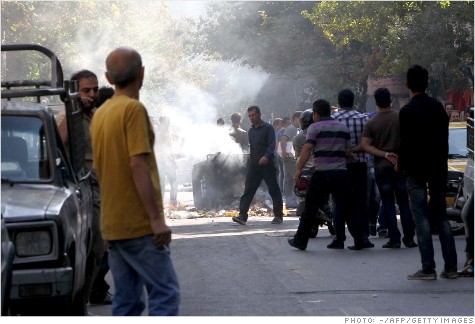
Iranian protesters scuffle with police in central Tehran in the first sign of public unrest over Iran's plunging currency. The rial lost more than half of its value since last week.
NEW YORK (CNNMoney) -- Iran's currency is in a free fall, and the sanctions over its nuclear program are mostly to blame.
Officially, the Iranian government offers to sell one U.S. dollar for about 12,500 Iranian rials. But it only offers that rate on a limited basis.
So Iranians, who need dollars to both buy imported goods and guard their savings against rampant inflation, have developed an extensive black market in dollars. It's on this market that the value of the rial has tumbled.
At the beginning of the year, rials on the black market were worth close to the official rate. But by late September, the rial had lost half its value, trading around 24,000 to the dollar.
In the last few days the currency has plummeted even further. Reports Wednesday said money changers in Tehran were charging 39,000 rial for a dollar -- a staggering 60% slide in a matter of days.
"This is one of the most intense episodes for the county in the last 100 years," said Gary Hufbauer, a senior fellow at the Peterson Institute for International Economics.
What sparked the rial's plunge
Most experts think the fall is a direct result of sanctions designed to get Iran to curtail its nuclear program, which Iranian leaders say is intended to generate nuclear power but many suspect could be used to produce a weapon.
The most recent rial plunge was sparked when the government said it would only offer the official exchange rate to importers of a few select items -- namely meat, grains and medicine. Importers who wanted to bring other consumer and industrial goods into the country -- most of which come from abroad -- would now be offered a rate from the government that is closer to the black market rate.
The move was an attempt to liberalize the currency market, squeeze the underworld traders and hopefully stabilize the frenzied rial.
Instead, it had the opposite effect.
By offering fewer dollars per rial, the Iranian government signaled to the people that it is trying to preserve the dollars it holds as foreign reserves -- in effect, preparing for a long bout with sanctions.
"It led to a loss of confidence among Iranians on the ability and willingness of the government to resolve the crisis," Behzad Yaghmaian, a professor of political economy at Ramapo College, told CNN.
Related: Iran arrests 16 in currency crisis
The sanctions, imposed largely by the U.S. and European Union, have cut Iran's oil exports in half. Oil exports are where Iran gets the majority of its dollars. Fewer dollars mean people are paying more rial to buy each one -- devaluing the rial. When the rial falls, the price of everything else goes up.
A popular bread called barbari -- which is made from imported wheat -- has gone from about 1,000 rials to about 5,000 rials. A local baker told CNN the cost will likely skyrocket further.
Feta cheese cost 50,000 rials per kilogram in March. The price has since tripled. Meat that cost up to 190,000 rials per kilogram then has doubled in price.
There are a few other explanations being floated for the sinking currency. Some Iranian officials have claimed black market traders were spreading rumors so they could profit off the rial's decline. Others say the Iranian government is restricting the flow of dollars into the economy so it can balance the budget on the back of a depressed rial.
But even Iranian President Mahmoud Ahmadinejad blames the sanctions. He said the currency drop is part of what he calls an economic war being waged against the country.
Whether the sanctions and resulting price spikes will be enough for the Iranian government to alter course on its nuclear program -- or to topple the government itself -- is another matter. So far Tehran has shown little interest in halting work on uranium enrichment capabilities that, if perfected, could quickly yield a bomb.
Analysts say the possibility of government reform remains remote.
Despite protests in Tehran Wednesday over the rial's fall, organized opposition to the government is weak, while the government's security apparatus is strong.
Plus, the country maintains populist programs designed to keep dissent at bay, including subsidized medicine, education and fuel.
"There has been no significant unrest during the rial's steep slide," Cliff Kupchan, a Middle East analyst at the Eurasia Group, wrote in a recent research note. "While this does not at all preclude future unrest, it suggests public tolerance for depreciation."
No comments:
Post a Comment